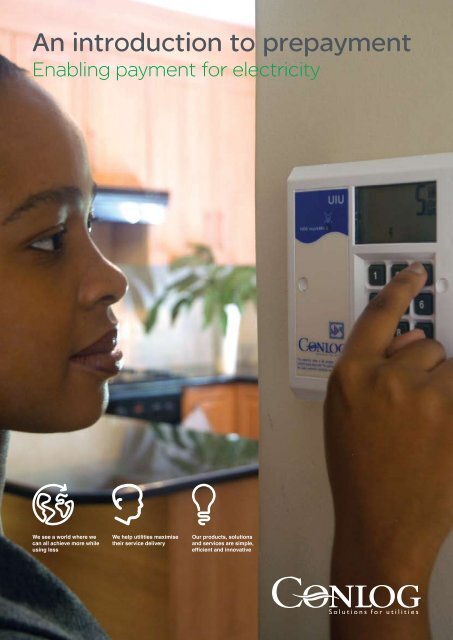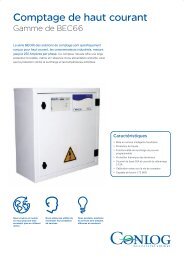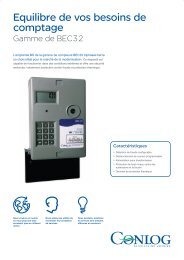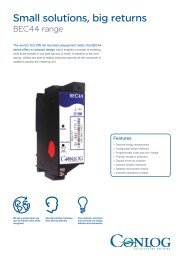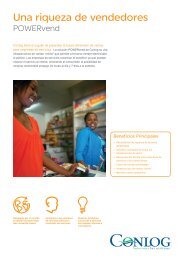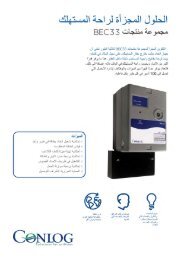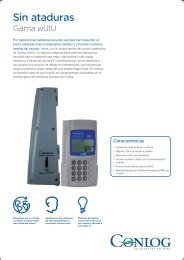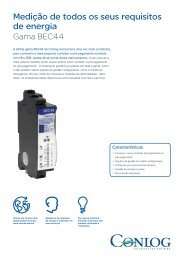An introduction to prepayment - Conlog
An introduction to prepayment - Conlog
An introduction to prepayment - Conlog
- TAGS
- introduction
- prepayment
- conlog
You also want an ePaper? Increase the reach of your titles
YUMPU automatically turns print PDFs into web optimized ePapers that Google loves.
Bringing power <strong>to</strong>the peopleElectricity <strong>prepayment</strong> has been in existence formany decades, however it was only in the late1980s, with the development of the numeric andelectronic transfer of credit, that the industry wasrevolutionised.Prior <strong>to</strong> this, many <strong>prepayment</strong> solutions were basedon coin-operated machines, whereby the user inserteda coin in<strong>to</strong> the machine and received electricity.Naturally this created a number of problems for theutility, not least tampering, as well as having <strong>to</strong> visit thevarious premises <strong>to</strong> empty the coins.However, the basic premise remains the same,whereby a consumer purchases their electricity needsin advance of consumption.Whilst the concept is simple, the technologicaladvances in the industry have enabled the adoptionof a wide variety of new methodologies, which hasimproved the service offering <strong>to</strong> both utilities and theirconsumers.How <strong>prepayment</strong> worksIn deploying a <strong>prepayment</strong> project, there are threefundamental components the utility needs <strong>to</strong> purchase.First, the <strong>prepayment</strong> electricity meter which isinstalled in the consumer’s premises. Next is thevending equipment, <strong>to</strong> enable consumers <strong>to</strong> purchaseelectricity, which should also be located near <strong>to</strong> theconsumers; and lastly a management system within theutility offices, <strong>to</strong> ensure complete financial control overthe project.The process thereafter is easy:> A <strong>Conlog</strong> <strong>prepayment</strong> meter is installed in theconsumers property.> The consumer needs <strong>to</strong> purchase electricity.This can be done by visiting a vendingoutlet, purchasing through the internet, or byredeeming a <strong>to</strong>ken via SMS.> The consumer will receive a 20-digit number,more commonly called a <strong>to</strong>ken.> This <strong>to</strong>ken is entered in<strong>to</strong> the meter, via thekeypad.> This loads the purchased amount of electricityin<strong>to</strong> the meter and the consumer enjoys anelectricity supply.> When the credit is depleted, the cus<strong>to</strong>mer simplypurchases a new <strong>to</strong>ken.> If a new <strong>to</strong>ken is not purchased, the electricityis suspended until a new <strong>to</strong>ken is entered in<strong>to</strong>the meter.A world of benefitsThe primary benefit for utilities is improved cashflow,as payment is received upfront from consumers. Inaddition, as there is no credit facility provided, there iszero consumer debt. Utilities can also enjoy reducedcosts as <strong>prepayment</strong> provides for a simpler andcheaper revenue collection cycle, which no longerrequires meter reading or accounts <strong>to</strong> be distributedeach month.<strong>Conlog</strong>P O Box 2332, Durban, 4000, South AfricaTel +27 (31) 268-1111 Fax +27 (31) 268-1500http://www.conlog.co.zainfo@conlog.co.za


